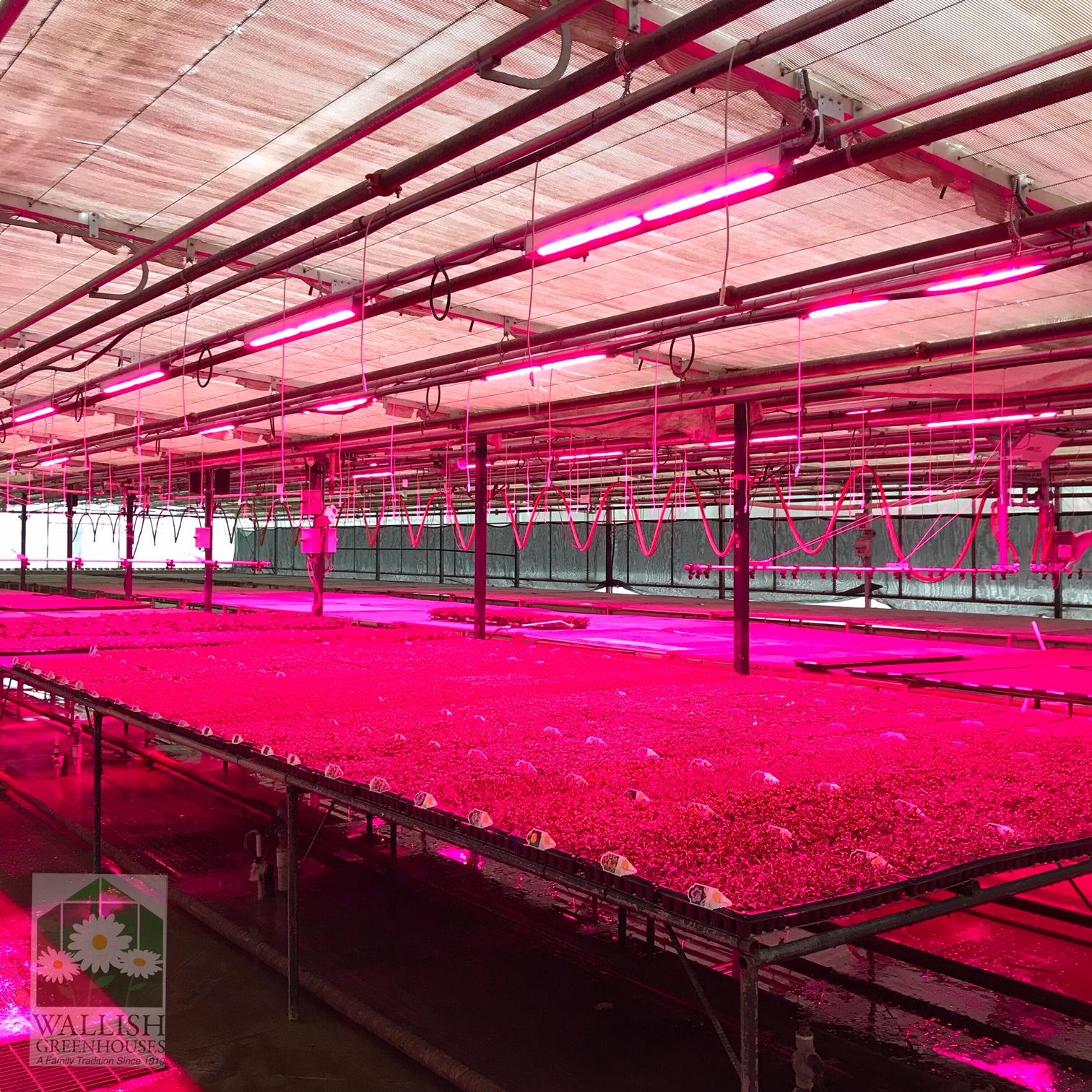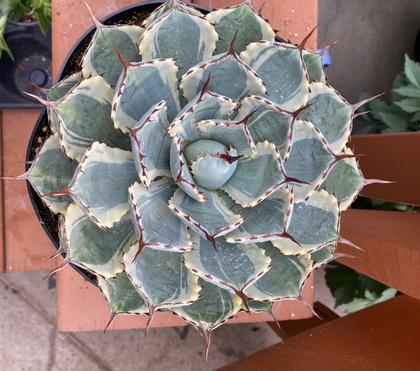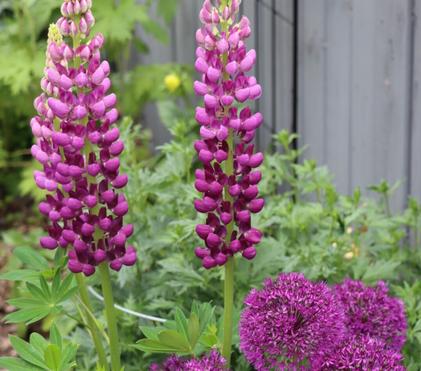How We Use Supplemental LED Grow Lights
For plants, light is life. Light is the crucial element for their growth – if we didn’t have light, we wouldn’t have plants. In the north where we live, adequate lighting from natural sources for growing plants can be hard to come by.
In this blog we will talk about photosynthesis, why supplemental lighting for plants is necessary and new trends in LED lighting for horticulture.

Photosynthesis
Plants use light for photosynthesis. The word ‘photo’ means ‘light’ and ‘synthesis’ means ‘to make’ or ‘to manufacture’.
Photosynthesis is the very complex process where plants, with the help of chlorophyll, combine light energy, water, and carbon dioxide into useable food or energy. Chlorophyll is a green pigmented substance that is held by chloroplasts within the plant structure – both in the leaves and the stems. That is what makes plants look green. Chlorophyll is one of the main players in photosynthesis. Plants absorb light through chlorophyll and this triggers the photosynthesis process.
The energy that plants derive from sunlight is used for:
- Plant growth: Leaf and stem structures grow larger and the plant grows more of them.
- Plant development: Differentiating plant structures in a crucial and dynamic process. It is essential for mechanisms like in flower growth and seed maturation.
Both of the above processes occur the same time and they also affect one another. Plant growth and plant development is an interdependent relationship.
Why Supplemental Grow Lighting is Necessary
Natural sunlight is the most abundant and cheapest source of light available to us, but we don’t always get light as we need it in the north during the winter months to grow plants indoors satisfactorily. We are short on:
- The quantity of light: because of the earth’s tilt, the sun stays close to the horizon and the light produced is below what we need for our growing needs.
- The quality of light: light is not as bright or as intense in the winter as it is in the spring and summer.
- The reliability of light: we can’t always count on light reliably because of things like winter fog, cloud cover, and snow cover, especially on greenhouse roofs.
The amount and type of light available to plants has an impact on plant growth. Low light scenarios can cause:
- Poor germination after the initial radical stage
- Stretching and elongation of seedlings
- Slowed growth due to a decrease in photosynthesis
- Decreased quality of growth
Because of this, artificial lighting in horticulture developed. We started using artificial lighting in our greenhouses in the early 1960s. At first we used a mixture of fluorescent bulb colours to mimic grow lights because the fluorescents were less expensive and that was what we could afford at the time. The lights were kept on a timer to stay on for 18 hours a day. Already then, growth improvement was evidenced by faster germination, and stockier and healthier growth. Growth regulators were always necessary, though, to control stretching.
As technology developed, we then moved on to using high pressure sodium lights (HPS). High pressure sodium lights provided more light, but the light produced was in the middle of the visible light spectrum. They did help with improved germination and growth, but growth regulators were still necessary because of the heat that was produced by the lights themselves.
LED lighting in horticulture is the result of continued research and discoveries on light and semiconductors. Researchers have been examining the light spectrum and its effect on plant growth since the late 1930s.
Sunlight, or visible light to our eyes, ranges from ultraviolet light to infrared light. It has been found that the red light & blue light regions are the colours that are used for photosynthetic CO2 assimilation, called the photosynthetic active region.
Ultraviolet light, or blue light, is on one end of the visible light spectrum and infrared light, or hyper red light is on the opposite end. Blue light has a short wavelength with high energy. Infrared light has longer wavelengths with lower energy. Most of the light on the infrared side is produced by heat.
Facts about Red Light and Blue Light
Plants absorb both deep blue and hyper red light through chlorophyll. Blue light provides a lot of energy & has an effect on the openings of stomata (plural for the word ‘stoma’). Stomata are microscopic openings on leaf surfaces that regulate the intake of water and carbon dioxide. Supplemental blue lighting results in thicker, darker green leaves, and stockier growth. Hyper red light has been found to trigger photosynthesis resulting in fast, tall growth and influence flower initiation. Manipulating blue and red light quantities at different stages of plant development can result in altered plant characteristics, like a taller plant or a sweeter tasting herb, but this is still in ongoing phases of research.
Currently, the recommended blue: red light ratio for growing plants with LED lights is 85% red to 15% blue. This formula seems to work the best because balancing reds & blues has to do with the differing energy outputs of these light sources at the two ends of the light spectrum. Because blue light has more energy than red light, fewer blue diodes are needed. Each species of plants has its own light spectrum ‘sweet spot’. This ratio provides a mix of red & blue that is best for most plants. This blue and red combination is what makes plant grow lights appear pink. For our human visual field, we see pink as a result of the blue and the red combined.
The new trend to move to LED lights within the horticultural industry has been driven by 2 basic forces:
- The desire to reduce energy consumption used both by the lights themselves and in food shipping.
- The need to improve the quantity and quality of food grown in local municipalities to reduce energy consumption used in trucking and shipping.
The Benefits of LED Growing Lights
Our experience with LEDs, which is confirmed by the scientific literature, has been positive. They do reduce energy consumption, and plant growth is improved.
In plants, LED lighting produces enhanced:
- Rooting
- Germination
- Plant uniformity
- Plant quality
- Control of seedling stretching
How Many Hours of Supplemental Grow Lighting is Recommended?
When it is deeply winter and lighting is compromised, specifically in January and February, 18-20 hours of lighting works well. Plants photosynthesize while the light is shining, but they always need a little down time during the dark to incorporate those sugars in their cell structure. As the hours and quality of sunlight improves towards the beginning of March, the lighting time sequence can be dropped back to 18 hours a day.
If you would like to continue this conversation, have any questions about supplemental growing lights, or would like to add to this dialogue; feel free to contact us – we would be happy to engage with you. In the meanwhile, enjoy growing!

